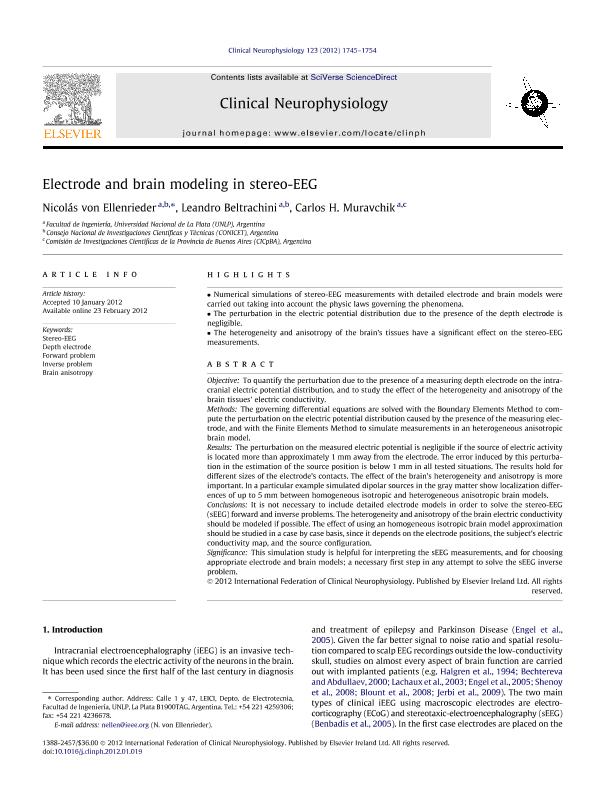Artículo
Electrode and brain modeling in stereo-EEG
Fecha de publicación:
09/2012
Editorial:
Elsevier Ireland
Revista:
Clinical Neurophysiology
ISSN:
1388-2457
Idioma:
Inglés
Tipo de recurso:
Artículo publicado
Clasificación temática:
Resumen
Objective: To quantify the perturbation due to the presence of a measuring depth electrode on the intracranial electric potential distribution, and to study the effect of the heterogeneity and anisotropy of the brain tissues' electric conductivity. Methods: The governing differential equations are solved with the Boundary Elements Method to compute the perturbation on the electric potential distribution caused by the presence of the measuring electrode, and with the Finite Elements Method to simulate measurements in an heterogeneous anisotropic brain model. Results: The perturbation on the measured electric potential is negligible if the source of electric activity is located more than approximately 1. mm away from the electrode. The error induced by this perturbation in the estimation of the source position is below 1. mm in all tested situations. The results hold for different sizes of the electrode's contacts. The effect of the brain's heterogeneity and anisotropy is more important. In a particular example simulated dipolar sources in the gray matter show localization differences of up to 5. mm between homogeneous isotropic and heterogeneous anisotropic brain models. Conclusions: It is not necessary to include detailed electrode models in order to solve the stereo-EEG (sEEG) forward and inverse problems. The heterogeneity and anisotropy of the brain electric conductivity should be modeled if possible. The effect of using an homogeneous isotropic brain model approximation should be studied in a case by case basis, since it depends on the electrode positions, the subject's electric conductivity map, and the source configuration. Significance: This simulation study is helpful for interpreting the sEEG measurements, and for choosing appropriate electrode and brain models; a necessary first step in any attempt to solve the sEEG inverse problem. © 2012 International Federation of Clinical Neurophysiology.
Palabras clave:
BRAIN ANISOTROPY
,
DEPTH ELECTRODE
,
FORWARD PROBLEM
,
INVERSE PROBLEM
,
STEREO-EEG
Archivos asociados
Licencia
Identificadores
Colecciones
Articulos(CCT - LA PLATA)
Articulos de CTRO.CIENTIFICO TECNOL.CONICET - LA PLATA
Articulos de CTRO.CIENTIFICO TECNOL.CONICET - LA PLATA
Citación
Von Ellenrieder, Nicolás; Beltrachini, Leandro; Muravchik, Carlos Horacio; Electrode and brain modeling in stereo-EEG; Elsevier Ireland; Clinical Neurophysiology; 123; 9; 9-2012; 1745-1754
Compartir
Altmétricas




